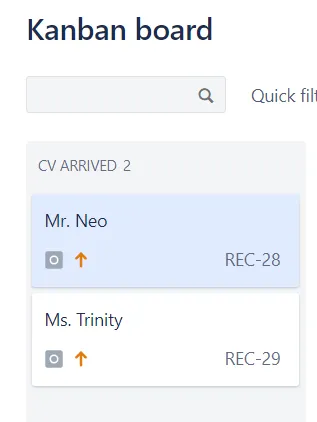
When you start hiring as a company it’s wise to begin with a simple solution in order to track your candidates and the various stages they are in. Once the volume of candidates and the positions you are hiring for increases, you need to come up with an easier way to keep everything in a manageable form.
In our case, we started out with a google sheet and google drive. This worked well for a while. After a point though, once you have CVs coming in from various directions(recruiters and job sites) and you need to place them in different stages(CV reviewed? Candidate Screened?) this scheme starts to become less than ideal.
As we are using kanban/scrum boards for most things(holiday-packing lists included ?) it felt natural to give it a try. Our current stab looks like this:

Our columns consist of the following categories:
- CV Arrived
- CV Reviewed
- Candidate Screening
- Candidate Onsite
- Candidate Offer
- Done
What this allows us to do, is to understand by a glimpse of how well we are doing in hiring for a particular role. If we see very few candidates arriving or making it to the later stages it means we need to make some changes or pick up the pace!
This also allows us to create smart filters that highlight CVs that remain too long eg. in the CV Arrived column as we don’t want to let people wait for too long before they receive an invitation(or not) for an interview.
Every detail about a candidate and the process is kept within the ticket and not in random emails, google drive documents or otherwise. This makes it super easy to review and provide feedback if having to decline. Every interviewer keeps the notes from each stage within the candidate’s ticket.
We love Slack. We also love its integrations! This has allowed us to hook up our Recruitment board with the relevant Slack channel we use to coordinate hiring. Every time we leave a note or move a candidate between recruitment phases, we get a notification so everyone’s aware.

Start to finish, the process is as follows:
- CV Arrives, it becomes a ticket in the first column with all the necessary information. CV, cover letter, description from recruiter.
- Someone reviews the CV and if happy, arranges the screening. Ticket is moved to Candidate Screening.
- After getting screened, the interviewer writes up the feedback on the ticket and if the candidate makes it, we arrange the onsite interview and move the ticket to Candidate OnSite. If the candidate doesn’t make it to the next stage go to (6).
- Once the onsite interview concludes, all interviewers provide their notes in the ticket. If the candidate doesn’t make it to the next stage go to (6).
- At that point, we make an offer and if hired the ticket is moved to Done.
- If the candidate fails at any stage, the notes kept in the ticket are used to provide a constructive rejection communication for the candidate to use going forward. No silent rejections here. Finally, the ticket is moved to Done.
If you need to separate the different jobs you are hiring for, you can leverage Swimlanes to separate each position.
Make sure to setup your security levels so only staff involved in recruiting has access to this information.
More over, with the advent of GDPR, there are a few issues that you need to be aware of when storing candidate data. As this is a long topic, I won’t expand here but you here’s a good summary.
Hope this helps in setting up your own recruitment process.